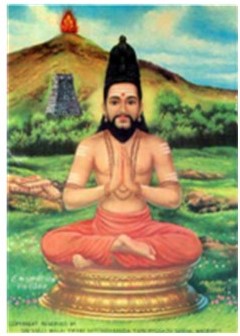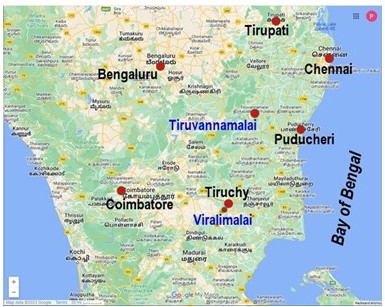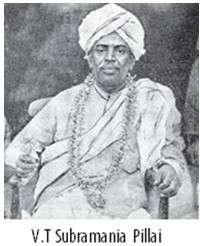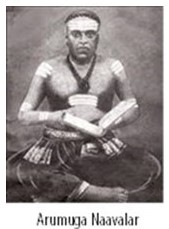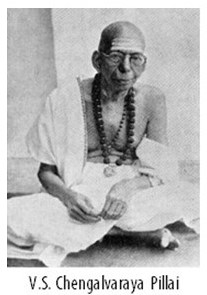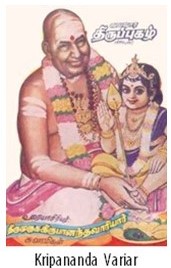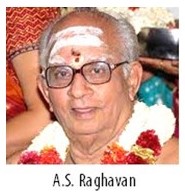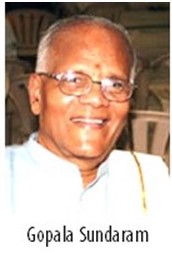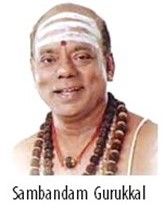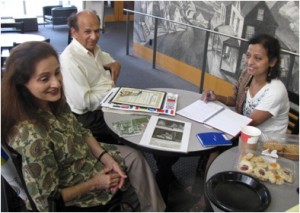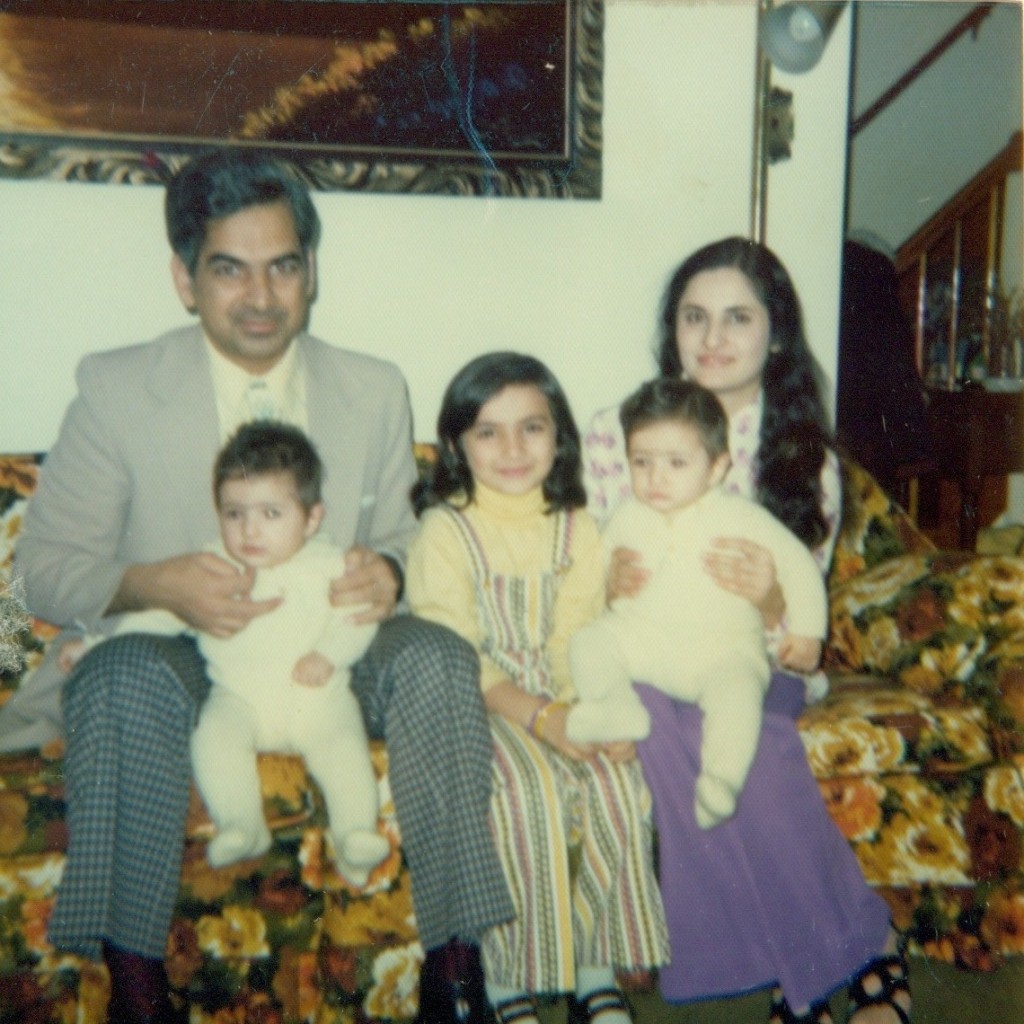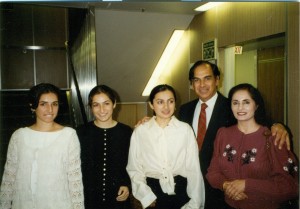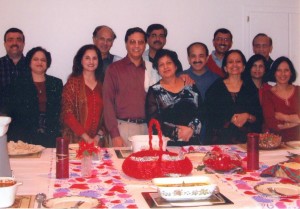Archive for category January 2015
Arunagirinaathar’s Life and Contribution to The Tamil Bhakti Literature
Posted by admin in January 2015 on May 30, 2023
By Kollengode S Venkataraman, Murrysville, PA
e-mail:ThePatrika@aol.com
Acknowledgments: M. Meenakshisundaram of Tiruchy, India for going over the drafts and offering valuable suggestions.
This article was written for the souvenir for Guha Ghosanam, a festival conducted in August, 2023 dedicated to Muruga-p-perumaan, at the Sri Siva Vishnu Temple, in Lahham, MD, a suburb of Washington DC.
In all faiths all over the world, admirers and devotees of great savants often add hagiographic embellishments to the lives of these sages, with some of these embellishments so fantastic that they confound rational minds. The admirers of Poet Arunagiri are no exception. His followers and devotees call him Arunagirinaathar (அருணகிரிநாதர், अरुनगिरिनादर), “nathar” a suffix added to his name out of their love and respect. This great Bhakti poet is known for his extraordinary poetical skills employing complex and varying rhythm patterns in his poems, his proficiency in Tamil and Sanskrit languages, and virtuosity in weaving into his poems the tenets of the Vedas, and stories from the Ramayana, the Mahabharata, and Siva, Vishnu, and Skanda Puranas. When you come to know of these, you too will admire him, and understand why his devotees call him Arunagirinaathar. Another unique feature in his poems is his mastery in trying to reconcile the conflicts between the Shaivites and Vaishnavites of his time.
Arunagirinaathar’s Time: His prolific religious-spiritual-poetical work was in the 15th century. He was born in 1370 Current Era and died in 1450 at the age of 80. He was born in the Sengunta Kaikolar community in Tiruvannamalai, the temple town for Arunachaleshawara in Tamil Nadu. In his poems, Arunagirinaathar refers to Prabhuda Devaraayan, the Vijayanagara king who ruled over the Tiravannamalai region in the 15th century, which confirms Arunagirinaathar’s time.
Arunagarinaathar’s life and lifestyle: In one of his poems starting with மனையவள் நகைக்க… … he describes his adult life, from which we can infer that he led a married life. From the structure and contents of his poems, there are strong reasons to believe that he lived close to temple dancers in the region. Living close to temple dancers — called Devadasis, a term not always used as a compliment — he saw in close quarters the lifestyles of the dancers living under the patronage of landlords and local kings. These dancers had to make many compromises in their lifestyles to live under such patronage.
In his poems the poet vividly describes the young dancers’ charm and beauty, the jewelry and clothes they wear, and the cosmetics and perfumes they use to enhance their beauty.
In over 1600 of his poems, Arunagirinaathar candidly acknowledges his proclivity for excessive indulgence in sensual pleasures. Recognizing this, he pleads for Muruga-p-peruman’s (literally, Lord Muruga’s) grace to wean himself away from this weakness.
In all societies throughout history, in people given to excessive indulgences of all types, we see radical transformations taking place quite abruptly. As if by a miracle, people voluntarily and without any struggle walk away from their lifestyle given to excesses. We hear about people among us making these kinds of abrupt U-turns in their lives — some of us even know them personally. When we ask them how they changed so suddenly, they struggle to explain the changes using logic. They attribute the abrupt changes for the better in their lives to Divine Intervention, or God’s Grace (இறைவன் அருள்).
Such a miraculous transformation happens to Arunagiri also, who was given to a profligate lifestyle. Recognizing this, he feels so despondent about his situation, as the popular story of his life goes, that he wanted to kill himself by jumping off a smaller Gopuram in the Arunachaleshwara Temple complex in Tiruvannamalai. As he was about to jump off the tower, he was miraculously stopped by Muruga-p-perumaan (Lord Muruga) Himself, telling him, “Your life is not to be wasted, and your mission is to save the lives of fallen people.” When Arunagiri pleaded how he can do it given his background, Muruga-p-perumaan (Lord Muruga) gives him the first phrases, முத்தைத்தரு பத்தித் திருநகை (Muththai-tharu-paththi-thirunagai) and disappears.
With the grace granted by Muruga-p-perumaan, Arunagirinaathar spontaneously composes his first song right there. You can listen to his first verse here:
www.youtube.com/watch?v=Fp7VAfmxJog,
and listen to Sambandam Gurukkal rendering the song in pulsating and lilting rhythm.
This was a great transforming moment in Arunagirinaathar’s life. He effortlessly abandoned his reckless lifestyle, becoming a mendicant and an ardent devotee of Muruga-p-perumaan. He later traveled all over South India and Sri Lanka, visiting over 200 Siva and Murugan temples, and composed songs addressing their presiding deities. Over 1600 poems are available in an anthology called திருப்புகழ் (Tiru-p-pugazh), meaning Divine Praise, most of them addressed to Muruga-p-peruman.
Arunagirinaathar’s poems in Tirup-pugazh are known for their lilting and pulsating complex rhythm patterns, known in Indian prosody as Chandas (छन्दस् in Devanagari, and சந்தம் in Tamil), meaning poetical meter. His poems are usually four- or eight-line verses consisting of 6, 8, 10, 12, 14, 16, or even 20 phrases in each line conforming to complex rhythm patterns. The poet keeps the same complex rhythm pattern in all the four or eight lines in each poem. This alone requires great linguistic skills purely in terms of prosody.
For example, his most popular poem muththai-tharu-paththi-thirunagai (முத்தைத்தரு பத்தித் திருநகை அத்திக்கிறை சத்திச் சரவண… …) follows the following rhythm pattern.:
tatta-tana tatta-tana-tana tatta-tana tatta-tana-tana
tatta-tana tatta-tana-tana — tana-taana
தத்த-தன தத்த-தனதன தத்த-தன தத்த-தனதன
தத்த-தன தத்த தனதன –– தனதான
Many Tamils know the name Tiru-p-pugazh, or at least would have heard the name. Not many would have read the verses or grasped their meanings. The verses have complex tongue-twisting phrases mixed with Tamil and Sanskrit words, written following Tamil and Sanskrit sandhi rules. This is difficult to grasp, especially for today’s Tamils with a limited knowledge of the Tamil language and its vocabulary because of the neglect of the Tamil in the school curriculum.
What is remarkable about Arunagirinaathar is that his skills in using complex rhythm patterns are only the base frame of skeleton in his poems. Around this frame, the poet builds complex stories giving us sensuous poems dripping in Bhakti (devotion). To fully understand and appreciate Arunanagirinaathar’s poems, one needs a good grasp of Tamil and Sanskrit vocabulary and grammar to get their basic meanings; and also to know of Sanatana Dharma’s tenets in the Vedas, Puranas, Ashtanga Yoga… … as we discussed earlier.
So, without the help of commentaries from scholars, it will be very difficult to understand and admire the prosodic skills of Arunagirinaathar and his grasp of all facets of the Sanatana Dharma. Here is a two-line example, first in the original form with the words fitted to flow with the rhythm pattern, and then with the words split to get some idea of what the poet conveys:
Rhythm pattern:
தாத்தனத் தானதன தாத்தனத் தானதன
தாத்தனத் தானதன …… தனதான
Original lyrics:
வாட்படச் சேனைபட வோட்டியொட் டாரையிறு மாப்புடைத் தாளரசர் …… பெருவாழ்வும்
மாத்திரைப் போதிலிடு காட்டினிற் போமெனஇல் வாழ்க்கைவிட் டேறுமடி …… யவர்போலக்
With words split for getting the meaning:
வாட்படச் சேனைபட ஓட்டி ஒட்டாரை
இறுமாப்புடைத்து ஆள் அரசர்… … பெருவாழ்வும்
மாத்திரைப் போதில் இடு காட்டினிற்
போமென இல் வாழ்க்கைவிட்டு ஏறும்… … அடியவர்போல
In these poems Arunagirinaathar openly and candidly pours out his proclivity to excessive sensual gratifications. He pleads for Muruga-p-peruman’s grace to wean himself away from his weakness, and move him towards the sublime. In his verses, Arunagirinaathar uses first-person singular, indicating his own personal struggle. When we read these poems constructed in first-person singular, we often feel that Arunagirinaathar is describing our own personal struggle on these matters.
A Unique Feature of Arunagirinaathar’s Poems: The schism between the Saiva and Vaishnava schools of worship in the Tamil country through the centuries is well known and there is no need to gloss over this division. Given this atmosphere, Arunagirinaathar is unique in the Tamil Bhakti literature.
Muruga-p-peruman is the son of Siva and Parvathi; with Parvathi being Vishnu’s sister, Murugan is also the nephew of Vishnu and Lakshmi.
Arunagirinaathar uses this puranic fact quite brilliantly and unabashedly in many poems. He would describe Muruga-p-perumaan as the son of Siva; and in the next breath and in the next line, as the nephew of Vishnu. Here is an example:
“O the Crimson-Colored (செய்யோய், a descriptive name for Muruga-p-peruman), the son of the One Who Wears Snakes as Garlands (reference to Shiva), and the nephew of the One Who Sleeps on the Bed of a Snake (reference to Vishnu), please grant me Your Grace.”
There are hundreds of references like this in his poems in which the poet refers to Lakshmi, Parvathi, Rama, Krishna, Arjuna, Ravana, Hanuman, Ganesha, and weaves episodes in the Ramayana and Mahabharata and the puranas into his poems. Why he did this in the 15th century is an interesting question for all of us to ponder over and see its relevance in the 21st century, here in the US.
How Arunagirinaathar’s poems were unearthed is a fascinating story. Arunagirinaathar’s contribution to Tamil literature in general, and Tamil Bhakti literature in particular, will be incomplete without the contributions of these great men:
V. T. Subramania Pillai (1846 – 1909): Till the late part of 19th century, Arunagirinaathar’s poems were not known to most people in Tamil Nadu. They were on palm leaves in homes of people in and around Tiruvannamalai and the Kaveri Delta area.
One Shri V. T. Subramania Pillai, a District Munsiiff and Judicial Officer under the British, in 1871 went to resolve a dispute at the Chidambaram Temple; the Temple’s Deekshitars quoted several verses from old Tamil bhakti poetry to make their claims. One such poem the Deekshitars quoted was from a verse of Arunagirinaathar. Fascinated by this verse, Subramania Pillai, a devotee of Muruga-p-peruman, wanted to know more about the person who wrote the poem, and he came to know of Arunagirinaathar. This started Subramania Pillai’s search for Arunagirinaathar’s poetry. He came to know of the sage’s six poems in a book by the great scholar Arumuga Naavalar (1822-1879), who lived in Jaffna, Sri Lanka.
Arumuga Naavalar’s contribution to preserving Saivism among the educated Tamils in Sri Lanka is considerable during the Portuguese and Dutch colonial occupation of Sri Lanka.
Starting with the six poems found in Arumuga Naavalar’s book, Shri Pillai went about his mission in his search for Arunagirinaathar’s works, said to be over 16,000 poems. He ended up collecting from various sources over 3,000 verses on palm leaves. He spent considerable time in sorting out his palm leaf collections, removing duplicates (which confirmed to him the authenticity of Arunagirinaathar’s works) and reconciling the same poems with different similar sounding words here and there. He and his sons Chengalvaraya Pillai and Shanmugam Pillai spent considerable amount of their time and personal resources in bringing out Arunagirinaathar’s poems in three volumes in the late 19th century and early 20th century. The Tamil literary World owes a great deal to V. T. Subramania Pillai and his two sons for bringing out Arunagirinaathar’s works for the outside world.
Kripananda Variar Swami (1906-1993): We owe a great deal to Kripananda Variar for painstakingly writing in six volumes detailed commentaries the Tiru-p-pugazh songs, giving word-by-word meaning and explaining the references to all the stories in the songs. This monu-mental work is necessary for anyone wanting to understand the nuanced meanings of the Tiru-p-pugazh verses in the context of Tamil Bhakti literature. Variar Swamy gave countless upanyasams and discourses on Tiru-p-pugazh all over the world. Incidentally, Variar Swamy was the inspiration for the Murugan Temple in Lanham, MD.
A. S Raghavan Sept 4, 1928-May 17, 2013), a government official in New Delhi, was so deeply impressed with Tiru-p-pugazh that he started a bhajan group in New Delhi. This grew over the years with people who learned from him the songs starting local chapters of Tiru-p-pugazh bhajans wherever they settled, including in the US. His group called Tiru-p-pugazh Anbargal (Friends of Tiruppugazh) set up branches in many parts of India and even outside. Details here: https://www.lokvani.com/lokvani/article.php?article_id=9938
For people with a decent grasp of the Tamil language and the basic tenets of the Sanatana Dharma, a very good source for Tiru-p-Pugazh songs and their general meanings is the website developed by Shri Gopala Sundaram at www.kaumaram.com/thiru/nnt0663_u.html. Gopala Sundaram’s website catalogs Arunagirinaathar’s Tiru-p-pugazh songs alphabetically, and also in terms of the temples on which the poems were composed.
You can listen, enjoy, and admire Arunagirinaathar’s complex rhythm patterns in Shri Pondicherry Sambandam Gurukkal’s excellent recordings of Tiru-p-pugazh songs here:
www.tinyurl.com/Sambandam-Gurukkal-1
www.tinyurl.com/Sambandam-Gurukkal-2
Shri Sambandam Gurukkal brings out the life in Arunagirinaathar’s verses with his grasp of Tamil Bhakti literary tradition and musical training.
Arunagirinaathar’s complex meters, Sanskrit and Tamil phrases, and descriptive names for deities in his poems are impossible to poetically translate into English or other European languages; and perhaps even into South Indian languages.
Fred Clothey, who was born to missionary parents in the Tamil country in the early 20th century, is the Professor Emeritus of Religious Studies at the University of Pittsburgh. He spent over 15 years in India, and also worked in Malaysia and Singapore. Clothey introduced Arunagirinaathar to English-speaking readers in his scholarly book Quiescence and Passion (now out of print), focusing on Kandar-Anubhuti and Kandar-Alankaaram. On the difficulty of translating Arunagirinaathar Clothey says:
“[My work] is a classic example of the kind of project into which fools rush where angels fear to tread. Neither my English nor Tamil qualifies me to translate poetically a Tamil poet who remains defiantly untranslatable… … [I got introduced to Arunagiri] in 1965 and sampled the poet’s unusual style. I have since come to know even better why none have dared to attempt a translation [of Arunagirinaathar] save in the most prosaic of ways.”
Tamil scholars in the 19th and 20th century who brought this great poet’ work to public attention are: The Tamil poet Pamban Swamigal (1848 -1929); The scholar-writer Vannasarapam Dhandapani Swamigal (1839 – 1898); A.S.Subramanian known as Thiru-p-pugazh Tha-tha; and Ki. Vaa. Jagannathan (1906-1988).
Arunagirinaathar left his mortal remains when he was 80 years in Tiruvannamalai. Every year in July the Murugan Temple in Viralimalai, (situated 18 miles southwest of Trichy in Tamil Nadu) organizes a music festival honoring Arunagirinaathar.
Arunagirinaathar life story is so captivating that the Tamil film industry made a full-length feature film Arunagirinaathar with the famous playback singer T.M. Soundararajan as the poet Arunagirinaathar. And the Government of India released a postage stamp (INR 50 denomination) in Arunagirinaathar’s honor. Arunagirinaathar’s other works:
• கந்தர் அனுபூதி Kanthar Anubhuthi – 51 verses, each four lines, with four phrases/line.
• கந்தர் அலங்காரம் Kanthar Alangaaram – 107 verses each four lines, with five phrases line
• கந்தர் அந்தாதி Kandar Anthaathi – 100 verses, each four lines, with five phrases/line.
• திருவகுப்பு Thiru Vaguppu
• வேல்விருத்தம் Vel Virutham – 10 verses each four lines, with twelve phrases/line.
• மயில் விருத்தம் Mayil Virutham – 11 verses each four lines with twelve phrases/line.
• சேவல் விருத்தம், Seval Viruttam and –11 verses each four lines with twelve phrases/line.
Arunagirinaathar’s expansive, enigmatic, and in-scrutable idea of Godhead, we can see in the last verse in Kandhar Anubhuthi:
உருவாய் அருவாய், உளதாய் இலதாய்
மருவாய் மலராய், மணியாய் ஒளியாய்க்
கருவாய் உயிராய்க், கதியாய் விதியாய்க்
குருவாய் வருவாய், அருள்வாய் குகனே.
Fred Clothey translated the above terse verse into English, capturing the great poet’s cryptic style in his English translation as well:
Formed, Formless; Being, Non-Being;
Flower, Fragrance; Jewel, Radiation;
Embryo, Life; Goal, Way;
Come Guha, [as my] Guru
[and] Grant [me] your Grace.
Arunagirinaathar’s devotees organize festivals for him periodically at the Tiruvannamalai temple and Murugan temples in India, and in Hindu Temples in Mauritius, Malaysia, Singapore, Sri Lanka, Australia, and North America.
After this discursive discussion, it may be appropriate to end this write-up by quoting a great terse phrase in Arunagirinaathar’s Kandar-Anubhuti, in which the poet recalls the advice Muruga-p-peruman gave him:
சும்மா இரு, சொல் அற,
literally meaning “Be Still, and Speak Not,” or better still, “Keep Quiet and Chatter not.”
It is worth noting that both Thaayumaanava Swamy (1705-1744) and Ramana Maharshi (1879-1950) adopted these phrases in their philosophical/spiritual works. And that is a delightful way to end this write up on the One-of-a-Kind Great Tamil Bhakti poet, Arunagirinaathar.
References:
1. Clothey, Fred, Quiescence and Passion, Publishers: Austin & Winfield, San Francisco, 1996, 177 pp. (now out of print, but available in a few bookstores and on-line book outlets.)
2. www.eng.arunagirinatharmanimandapam.org/scholars-of-tirupugazh/
3. Kripananda Variar, Tiru-p-pugazh Virivurai, in six volumes, Publishers: Vaanathi Pathippagar, T.Nagar, Chennai, 1985 onwards.
4. www.kaumaram.com/thiru/nnt0663_u.html.
5. www.tinyurl.com/Sambandam-Gurukkal-1
6. www.tinyurl.com/Sambandam-Gurukkal-2
__________________________________________
About the author: Kollengode S. Venkataraman, lives in the Pittsburgh metro area since mid1980s, and is the editor and publisher of a 28-year-old independent quarterly magazine, The Pittsburgh Patrika, (www.pittsburghpatrika.com).
Juginder and Dolly Luthra: Reviving Weirton’s Festival of Nations
Posted by admin in January 2015 on June 14, 2022
By Nandini Mandal e-mail: nandini@nandanik.com
Note: Nandini Mandal, the artistic director of Nandanik Dance Academy, recently spoke to Juginder and Dolly Luthra of Weirton, WV, on their participation in reviving Weirton’s Festival of Nations, last held in 1944. She met the Luthras at CMU.
Their story started as a Bollywood-style romance. From the forced migration during India’s painful Partition in 1947, to fifty years later, reviving a defunct Festival of Nations in Weirton, WV, through organizing an Indian Cultural Day there. And their story still continues.
He was born in Multan, in Pakistan now. His family, like other millions, was uprooted during the 1947 Partition and settled down in Panipat, in today’s Haryana, India. Seventh child in the family, he joined the medical school in Amritsar in 1961, obeying his father’s decision.
Three years later, a lovely young lady joined the same medical school in dentistry. Originally from Bombay, she moved to Chandigarh as her father was part of Le Corbusier’s architectural team that built Chandigarh. At the college social, they were part of the play together, with the lovely woman getting the best actress prize. He, Juginder, was in his third year, and she, Dolly, was in her first. And the rest was their destiny together.
Juginder and Dolly were married in 1968, and they moved to the U.K. in 1974 with their first daughter Namita. Juginder Luthra, an ophthalmologist, got his advance diploma in UK. Soon after, their twin baby girls, Rohini and Rashmi, arrived. The Luthras eventually wanted to reach the US shores.
With America still recovering from the Vietnam War, there was a dearth of qualified and experienced doctors in many cities, including Weirton, WV. One of his friends already in Weirton asked him to come to Weirton to practice medicine. In 1975, the Luthras arrived at Weirton with their three daughters.
While Dolly stayed home for eight years to raise their daughters before starting her dentistry practice, Juginder worked as a house physician at the Weirton Medical Center. Weirton was now their home away from home. Juginder recalls, “Our neighbors embraced us, giving us car rides, taught us driving in our very early days as immigrants.”
To find out how this Punjab da puttar (son of Punjab) became intertwined with the heart and soul of Weirton decades later, we need to understand Weirton’s history built around steel. The economy of Weirton (population 30,000 at its peak) was driven by the steel mill with 13,000 employees at its peak.
In 1909, Ernest T. Weir established a Tin Plate Mill near Holliday’s Cove, a farming village, calling it Weirton, an unincorporated company town. With the expanding mill and an influx of European immigrants, Weirton was incorporated in 1947 by merging several neighboring communities around the mill.
As is the case with all steel towns in the US, Russian, Polish, Greek, Slavic, Italian, Finnish, Hungarian, Welsh, Dutch, Spanish immigrants, and native African-Americans flocked to Weirton in the early 20th century. The interactions among the disparate immigrant groups were not always smooth. A large number of immigrants living in close proximity in a small, isolated town without a strong common American identity was a cause for concern for leaders of the community.
So, in 1934 Weirton’s civic and business leaders conceived a Festival of Nations to foster a sense of fellowship and social and cultural interactions among the ethnic groups. They wanted to showcase the diverse culture in a noncompetitive atmosphere. They succeeded in their mission, and until 1939, the Festival of Nations continued in this spirit with ten nationality groups’ participation in the thousands.
Then World War II started in 1939, ending in 1945. The returning victorious soldiers and the people at large were forged with a common American identity. With this, the rationale for the Festival of Nations too ended, the last one was in 1944.
Good times roared for decades. But with steel’s decline in the 70s, Weirton was devastated like other US towns built around steel. Today Weirton’s population is only 19,000, with only 1000 in steel! Weirton is a now a bedroom community to people working in Robinson Township and the Airport areas.
Flash forward to 2006. The Luthras, now well-established in Weirton, and both ardent art lovers and patrons, decided to showcase India’s dance and musical extravaganza to the people of Weirton. They dipped into the Indian talents in Pittsburgh with artistes trained in India’s rich musical and dance traditions. Sponsored by the Weirton Area Museum and Cultural Center, the Luthras organized the event with Nandanik Dance Academy, Nidrita and Asish Sinha, and Sushanta Banerjee performing in an hour-long program. It was a hit with the audience.
Impressed by the event, Weirton Mayor William Miller, surprised the Luthras by declaring November 18, 2006 “India Heritage Day” in Weirton. The Luthras, now members of the Board of Directors for the Weirton Area Museum and Cultural Center, added a new dimension to Weirton’s cultural landscape.
Then came the Weirton’s centennial in 2009. In a meeting participated by Weirton’s civic and business leaders and community organizers, old-timers wanted to revive the Festival of Nations. Juginder says, “Many of us, including those who have lived here for a long time, had never heard of it before. When they heard about the festival from old-timers, everyone asked me, Why don’t we create something like you did on India?'”
Weirton’s glorious legacy, now seen through faded photographs and recalled by elders helped in its revival in 2009. The Luthras were active for three years — they were the chair and co-chair of the organizing committee — trying to reconnect to Weirton’s past with help from countless citizens of Weirton.
The Festival of Nations was re-started in 2009 with a parade, all singing We are the World at the Municipal Building, with artistes from Weirton and its extended neighborhood including Pittsburgh participating
Every year, attendance improved, starting from mere 400 to over 1600 people this year with twenty-one ethnic groups participating. Indians, Chinese, Koreans, and Japanese are the new entrants. People come back to participate in the parade, buy artifacts from display tables, and taste the featured multiethnic food. The Luthras made sure the gala started with an invocatory piece by Dell Fryer, or Chief White Panther, a Delaware Native American chief.
Now having acquired a building for the museum with a grant of $30,000 from the J.C. Williams foundation, the Luthras and their fellow townsmen are pleased that they were able to revive the Festival of Nations. While recognizing that the festival had seen better days in the past, they hope that it will grow in the years ahead.
Dolly Luthra says, “When my father, a PWD (Public Works Department) engineer, was part of the team that built Chandigarh in India, little did I know that decades later, I will be involved in trying to rebuild another city not physically, but culturally, far away from India. That is very satisfying to me.â€
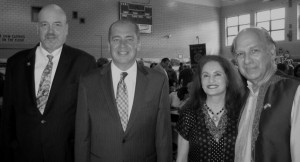
The Luthras are also path breakers in other ways. They are the founding members of Triveni, a cultural organization with Bangladeshi, Indian, Pakistani members to share the common ethos of the Indian subcontinent. Under the Triveni banner, in 2010 the Luthras were instrumental in showcasing the creativity of visual artists among Indians in the Pittsburgh Metro area under one roof in Monroeville to display their works.
Soft-spoken and warm, the Luthra’s dedication to Weirton that has seen better days is admirable. The Luthras went forward with the limited resources they had.
Along the way, in their efforts to rebuild the Weirton’s glorious legacy, they have befriended a diverse cross section of people in the community. Weiron too, has embraced them even tighter than before. ∎
Retirement Communities and Senior Centers for Indian Immigrants to the USA
Posted by admin in January 2015 on February 6, 2022
Balwant N. Dixit PhD Phone: (412) 963-8023
(I respectfully dedicate this paper to the Late Dr. Ashok Sapre of Murrieta, California for his pioneering efforts in promoting ideas to help Indian immigrant seniors to the North America. His numerous contributions have led the path for all of us to follow. Dr. Sapre passed away on September 14, 2021)
Note: The most of the information mentioned in this article about the Indian Retirement Communities and senior centers is obtained from respective websites. Most often website information is given for promotional purposes and emphasizes most desirable aspects. The graphics are also not realistic since they are most often generated from computer graphics. It is very difficult to get the real information except when a person visits an establishment and spends time and gathers information from the residents and managers. Such visits are rare. One example is a brief report made by the late Dr. Ashok Sapre on ShantiNiketan.
Indian immigration to the USA: I arrived in the USA from India in 1962 on a one year International Fellowship in Pharmacology. At that time there were only about 4000 persons of Indian origin in the USA. Although Indian immigrants entered the USA as early as1920 significant immigration is of very recent origin because of the legislative barriers due to the laws such as the 1917 Immigration Act preventing any immigration from India. As of 2019 there were about 2.7 million Indian immigrants in the USA. This increase was principally due to the passage by US Congress of the 1965 Immigration & Nationality Act removing national-origin quotas and basing immigration on having the economically desirable skills. This was the reason that from 1980 to 2019 the Indian immigrant population in the USA increased almost 13 fold, reflecting in the fact that most of the current Indian Immigrants (about 2,500,000) are comparatively a young ranging 35 to 70 yrs. in age. Then there is a significant income disparity between the early immigrants and the later arrivals. However, no reliable quantitative data are available. This highly skewed population in age and in income has important consequences as related to retirement readiness. In the USA population of 330 million, about 54 million are over 65 and retired (16.3%) and verifiable data on what USA Senior citizens want as far as their retirement is concerned are easily available, while in the Indian 65+ seniors estimated at about 200,000 (7.4%) it is very difficult to ascertain what Indian seniors want, since verifiable data are unavailable.
The Retirement Communities in the USA.
There are an estimated 80,000 Retirement Communities of various types, operated by organizations (for profit, non-profit, religious, self-managed etc.) serving 25 + million USA senior citizens, mostly complying with the Federal Fair Housing Act of 1968. As far as I know, several hundred Indian immigrants have moved into the age based American Independent retirement communities such as the Sun City Center in Florida, Age based Independent retirement Community in Marietta, California, Traditions of America near Pittsburgh, Pennsylvania and in a few other states.
Earlier efforts made to build “For Indians Only” Retirement Community in the USA.
In 2007, a workshop by the National Indo-American Association for Senior Citizens (NIAASC) was organized in New York and the following items were discussed. Where to spend golden years” for those who immigrated to USA in early 60s. Since the Joint family system was no longer a viable option for those in the USA and it may not be feasible for most NRIs to move back to India OR to stay with their children in the USA, a plan was announced to develop a retirement community near Atlantic City, (NJ), for the seniors of Indian origin, slated to open in 2008. For various reasons the venue was changed to Florida. A suitable site was selected in the Taveres County near Orlando and plans were finalized to construct a facility called ShantiNiketan. The ground breaking ceremony took place on June 17, 2009 at the hands of Iggy Ignatius, the originator & CEO.
Current, age based (55+ or 60+), independent Retirement Communities for Indian Immigrants, in the USA.
(i) Ownership:
| Name of the Community, type of housing & Contact details | Location (State) | Type of the facility | Amenities | Present status and remarks |
| ShantiNiketan (Houses, Condos and townhouses). Contact: (352) 508.7060 | Florida | Age based Independent living. No provision for long term care. Nursing care facility under consideration | Dining Hall/Theater. Daily chef prepared three vegetarian meals. Each residential unit with its own kitchen. Prayer room, Library/Computer room, club house with a gym | Development in several phases. Over 150 units sold out. Some of the houses/condos owned by seasonal occupants |
| Serenity Reserve (85 Houses). Contact: (407) 212-0123 (JAGK7518@GMAIL.COM) | Florida | Age based Independent living. No provision for long term care. | Club house, pool, central kitchen, banquet hall, outdoor lounge, fitness center, yoga and meditation room, library, movie theater | Sold out. Opportunities for resale exist |
| Anand Vihar (Houses & Townhouses (Costs from $179,000 to $329,000) | Florida | Age based Independent living. No provision for long term care. | A recreation center, a swimming pool. A dining hall with flexible meal options, a fitness center, a movie/media room, tennis and pickle ball courts, a prayer & meditation room and a gazebo for relaxing | Sold out. Some of the houses/condos owned by seasonal occupants. Opportunities for resale exist |
| Nalanda Estates (83 homes. Cost: $305,990 to $525,990. Contact: | Florida | Age based Independent living. No provision for long term care. | Club house, banquet hall, Commercial kitchen, fitness center, prayer room, walking trails, theater, zen garden | Sold out. Opportunities for resale exist |
| Verandah (51 Townhomes, 75 Condos and several houses, Handicapped accessible (Costs from $390,000, with monthly charges, $4,637-$6,028. Contact: (312) 952-1802. (verandahretirementcommunity@gmail.com) | Illinois (Chicago) | A CCRC with a 100 bed hospital on the campus | Dining room, library, Beauty salon, Restaurant-style dining. Indian and American Lifestyles | Sold out |
(ii) Rental Apartments
Priya Living: Various locations in California with completely furnished rental apartments for senior citizens, with unique shared spaces and Innovative programming. Contact: 408 – 310 – 5112. (namaste@priyaliving.com). Monthly rent: $2,395-$3,100
| Name of the Community | Location | Type of the facility | Amenities |
| CITY CENTER. | Fremont, CA.94538. | Independent living. No provision for long term care | Outdoor recreation spaces, an indoor community kitchen, a pool and cabana. Open Courtyard All amenities not available at every campus. |
| WARM SPRINGS | Fremont, CA. Located in the Bay Area | ||
| CIVIC CENTER | Santa Clara, CA. Silicon valley |
Retirement Communities in the planning stages
| Name of the Community & type of housing | Location | Type of the facility | Amenities | Present status and remarks |
| Athashri (Contact: Inquiry@dahlingroup.com). Costs: $460,000 – $740,000 | Hayward, CA. | Independent living, with 150+ condominiums + three single family homes (1-3 BR) | A kitchen + living space of 700-1800 sq. ft. Swimming pool, wellness center | Original developers: Pristine Homes, CA + Paranjape Schemes, Pune, India. Future plans uncertain due to problems with financing |
| Vishram Kuteer An active 55+adult community with houses. Prices: $123,000 – $215,000. Contact: (281) 337-5133 | Rosenberg TX | Independent living | Located on 23 Acres with two lakes, a recreation facility, a common vegetable garden, a meditation area, and a small Hindu Temple | Uncertain future |
| Apna Ghar. 7228 Blanco Drive, Irving, Texas 75039. Contact: +1 (817) 891-7770 | Texas (Dallas) | Independent living community | Yoga classes, Health seminars, Movie Theater next door, Relaxing room with playing cards, domino, Carrom Game, Large outdoor Patio with pool and Waterfall. Three vegetarian meals, | Proposed |
| Anand Vihar. Contact: Anand Patel, Pangea Realty Group, 1211 Tech Blvd. #150, Tampa, FL 33619 | Georgia (Atlanta) | A high-rise luxury condo community for Indian seniors with a potential for an assisted living facility | A covered parking garage, indoor and outdoor pools, meeting spaces and a dining hall. | Proposed |
Nursing Care Facilities for Indian Immigrants
The “Indian Nursing Home” Program started by Dr. Mukund Thakar, a pioneer in providing nursing care services to Indian Seniors living in the USA located in (i) Kings Harbor Multicare Center (NY) (ii) Arista Care Centers (NJ) and at (iii) Smaller facilities at several other locations.
Care is provided by Indian doctors, Indian nurses and Indian therapists speaking Hindi, Punjabi and Gujarathi, with Indian vegetarian food, Indian Prayer service, a Hindu temple, Traditional Indian festivals, Indian television shows and Indian music.
The following statement by Dr. Mukund Thakar is worth mentioning here and I hope some Maharashtrian physicians and health care workers follow Dr. Thakar’s steps. “Taking care of the elderly has been my passion since I began my career as a medical professional and now I have the honor of catering to their needs 24 hours a day. I had a vision of establishing an Indian nursing home program to accommodate the Indian elderly. The Indian nursing home program was developed in 2005 by creating an environment where the Indian elderly would feel comfortable in their living arrangement and where their medical and personal needs are met to ensure their well-being and happiness.
My staff and I have been providing exceptional quality care to our Indian senior citizens from all over the country. The accurate formula of medical care enriched with the Indian culture has revolutionized the way our senior citizens are cared for in nursing homes. With multiple programs operating successfully in New Jersey and New York, I would personally like to invite you to take a tour of this unique program that brings comfort, culture, and care together under one roof.” Contact: (https://myindiannursinghome.com/)
Some observations, some questions and some freewheeling thoughts
(1) “For Indians only” retirement communities currently provide housing for around 1500 seniors out of an estimated 150,000 to 20,000 Indian seniors in the USA
(2) Almost all “For Indians” retirement communities have no provision for much needed assisted living /nursing care. Exception being Veranda in Chicago and a stand-alone Mukund Thakkar’s Arista care in NJ and New York
(3) Currently relatively very few “For Indian only” retirement communities are functional in the USA. What are the reasons? Is it the lack of interest or the lack of demand or the lack of capital or the lack of reliable market research?
(4) Why so few Indian Immigrants want to move into a retirement community for Indians?
(5) What factors determine where Indian seniors want to retire?
(6) Many Indian seniors prefer to move near their siblings, but not with them. Why?
(7) No reliable data to indicate the thinking of Indian seniors as what they want
(8) No representative business organization that can provide reliable data on Indian Seniors on retirement issues is present as it is there for the American Retirement Communities
(9) Let Indian seniors join a senior care community (such as a CCRC) that can provide all the necessary care from A to Z. Needs lot of financial recourses. There are 2000 such communities in the USA
(10) Go by yourself and take care of yourselves the best way you can with whatever resources you can muster and with whatever help you can get.
(11) Let us negotiate with our grown up children in what way we can help them in advancing their life objectives such as the education of their children (e. g. by contribution to the 529 college savings plans), improving their house etc. and in return request them to accommodate us and our limited needs. This is already happening on a ver limited scale. It may be necessary to modify their existing house. Reestablish JOINT FAMILY structure with a modern twist!
(12) Let the seniors join any age defined Independent American Retirement Community, and sign up for a Continuing Care at Home Program (CCHP) or call any of the Home Care agencies, such as Home Instead, to receive the care one needs at home.
(13) Almost every city in the USA has several Indian Restaurant. Arrange a “Meals on Wheel” type of meal delivery program (e.g. 5 days/week) to seniors by subscription.
Senior Citizen Centers
A Senior Citizen Center (SCC) is a relatively recent origin in the USA and it is in the very early stages as far as Indian Seniors in the USA are concerned. SCC is a type of community center where older adults can congregate to fulfill many of their social, physical, emotional, and intellectual needs. In the USA, many towns have senior centers that are usually locally funded, though some may receive state and federal money. An estimated 11,000 such centers serving about 1 million seniors are functional in the USA. Usual activities at a typical Senior Center: Health & Wellness Programs, Personal growth and learning, Computer classes, Woodworking and other hobbies such as Knitting, Painting, Photography, Ceramics etc., Driver’s safety program, Nutrition & Culinary classes, Advice on retirement investments & financial planning and income taxes
Senior Citizen Centers for Indians in the USA: Relatively few, mostly located in large cities such as the New York City, Chicago, Los Angeles, San Francisco etc. “India Home” is one such Senior Centers, opened in 2014 serving the (60+) South Asian Seniors in the New York City. It serves the South Asians-one of the fastest growing and most overlooked groups of elderly in New York City.
In the Pittsburgh area currently there are two Indian Senior Centers that are very effectively providing very valuable services to the India seniors.
(1) United Seniors Association of Pittsburgh (USAP) is a service organization of senior citizens. Currently it does not have its own facility but functions very effectively as a virtual senior center. It was founded in 2017 by the seniors and for the seniors. USAP is registered as a non-profit, charitable, tax-exempt organization under the State Laws of Pennsylvania. Its goal is to promote healthy aging not only physically, but also mentally and spiritually, through education and physical participation. Anyone above age 50 is welcome to join USAP irrespective of race, religion, or nationality. Contact: (412) 908-1711. (USAofPittsburgh@gmail.com).
(2) Dhru & Gul Bhagwanani Pittsburgh Indian Senior Center (DGBP ISC): 3955 Monroeville Blvd. Monroeville, Pa 15146 with an entrance from Business 22, 3946 Wm Penn Hwy. Monroeville, Pa 15146. Total area of 4500 sq. ft. to be opened in mid-2022: It consists of an office, exercise Room, a small prayer room (temple), a social hall, a dining hall, a nap room or a resting room (emergency use), a full service commercial kitchen and a meeting room/ social hall with the capacity of 100 and designated parking for the handicapped. All facilities will be compliant with the 1990 Americans with Disabilities Act (ADA). The entrance and access will be located at the street level. It is being funded from a trust left by a physician & her husband, and donations received from patrons. The center is planned to have senior friendly & modern high-tech amenities as well as safety & security. The attendees will not need to pay any fees or charges for the facility, food & all the activities & programs offered.
Aksharaabhyasam in Pittsburgh on Vijayadasami Day During the Sharada Navaratri in Fall 2021
Posted by admin in January 2015 on December 13, 2021
By K S Venkataraman
During Vijayadasami (the 10th and the concluding day of the Sharada Navaratri in Fall, which was in October 2021 this year), the Pittsburgh Chinmaya Mission organized the traditional akshara-abhyasam ceremony, initiating the 4 to 6-year-olds to their long journey — 20 or more years — in studies, learning and education.
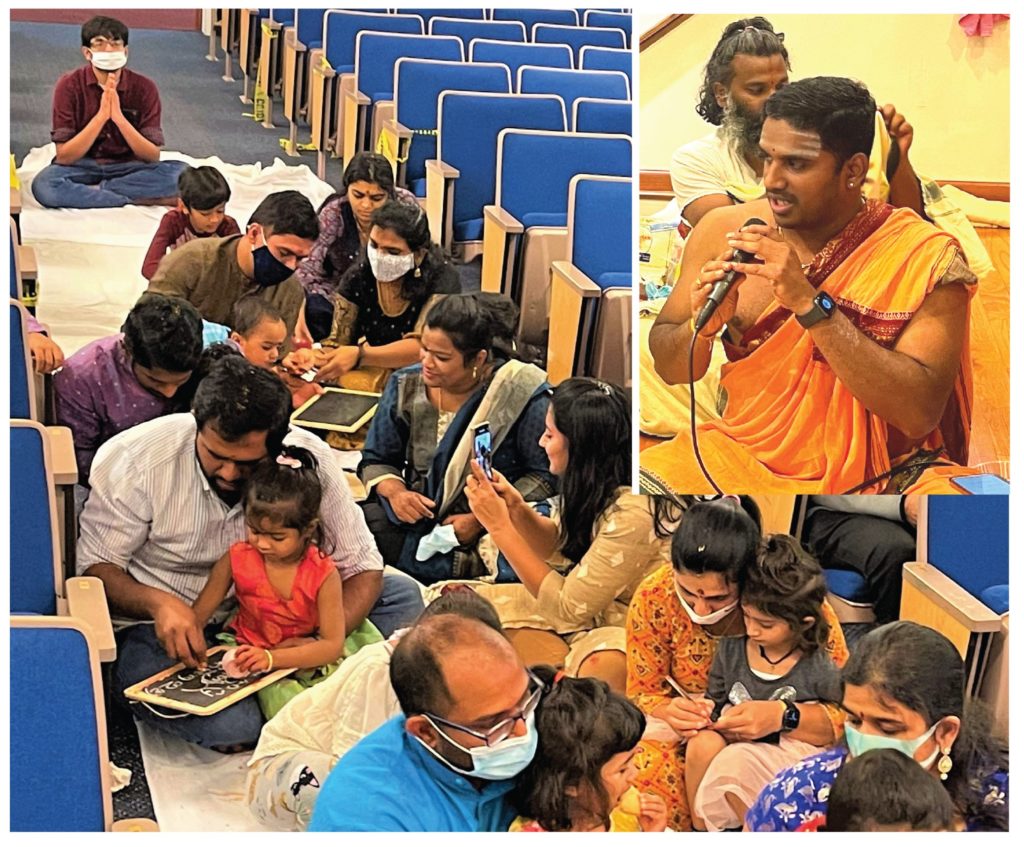
In the picture above, Pandit Shri Dharmateja Nagalingam at the Mission is helping parents with children sitting on their laps to write Om Ganeshaaya namah, Om Vaagdevyai namah or Om Namasshivaya or Om Narayanaya namah on slates using chalk pieces while reciting Sanskrit hymns.
==========================================================
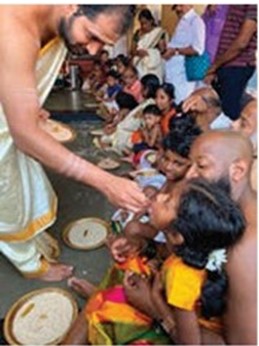
Typical Aksharabhyasam ceremony at the famous Mookambika Temple where the presiding Devi is worshipped as Saraswati, Lakshmi and Parashakti.
This famous temple is situated close to Mangaluru in Karnataka, India. Here parents or family elders initiate their kids to writing on rice paddy spread on brass plates using turmeric root as pencils. A detailed article here: www.tinyurl.com/aksharabhyasam-MookambikeTmpl ∎ — END

